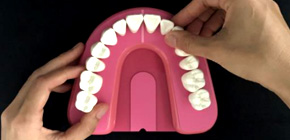
Hands-on oral cavity model DENTACT
Will close information gap for visually impaired individuals
A group of researchers from the Division of Special Care Dentistry, Osaka University Dental Hospital; Institute for Dental Technology, School of Dentistry, Osaka University; and the National Center for University Entrance Examinations developed the oral cavity model DENTACT (a dental information system with tactile illustrations and braille explanation) which can be used for oral healthcare education for individuals with visual impediments. This model will receive the Good Design Award 2017.
Tooth brushing is the most important habit for preventing oral diseases and it’s necessary to learn the correct brushing technique from childhood. In addition, as people get old and their oral cavities change, they also need to receive professional oral hygiene advice. However, individuals with visual impairments cannot see their teeth alignment, the parts that are easily stained, or the angle at which they should place the toothbrush on their gums. It’s difficult for them to learn proper brushing technique, so they are likely to develop cavities and gum disease. Currently, there are no materials for dental hygiene education to allow visually impaired individuals to learn through touch, so education for them using haptic educational materials has not become widespread.
In designing a model, this group aimed to make it possible to reproduce the states of teeth of various people easily and quickly and to make it easy for visually impaired individuals to learn their teeth alignment and the angle to place a toothbrush to the gums through touching. The model has detachable magnet tooth pieces, so various states of the teeth of subjects can be easily reproduced, through which they can learn their teeth alignment and brushing technique.
In addition to adult and baby tooth pieces, this model has tooth pieces that begin to break through the gums as well. Thus, this innovative model can faithfully reproduce various states of teeth in a wide range of individuals ranging from child to adult, which vary in number, type, and alignment of teeth. Based on advice from visually-impaired individuals, numerous improvements have made to this model, which allows people to understand the state of their teeth.
It is hoped that this model will help individuals both with and without visual impairments to understand their oral state and will achieve reasonable accommodation for visually impaired individuals defined by the Act on Elimination of Disability Discrimination by ensuring provision of information. This model of a universal design helps everyone to understand their oral conditions easily, so it is likely to be used for oral healthcare education as well.
Figure 1
Figure 2
Figure 3
